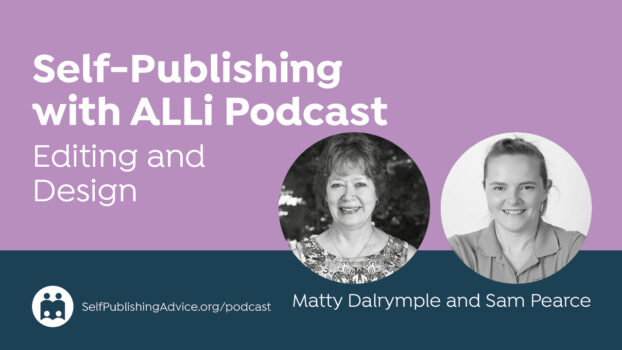
Photo by Gabrielle Henderson on Unsplash
There are different ways to get started when writing a book. Some authors prefer to write spontaneously, seeing how one action leads to the next as they write. These authors are often described as ‘Pantsers’ meaning they write ‘by the seat of their pants’! We’ll be covering this writing approach in a future blog. In this post, we’re looking at the plotter (or ‘planner’ for non-fiction) approach, with advice provided by ALLi partner member 1106 Design.
Plotters and planners prefer to outline, all – or almost all – of their book before getting going with the writing itself. If you’re a plotter/planner looking to tighten up your technique, or a pantser seeking a new approach, today’s post will talk through the first steps.
And if you are a pantser shifting gear… take a look at our blog post from the archives with Kassandra Lamb explaining why she made the shift and why she’s happy she did: Pantser to Plotter.
How to Plan Your Indie Book
There are many advantages to outlining your book before you begin writing, not the least of which is being less likely to write yourself into a corner. Outlining also gives you a chance to determine what research, if any, will be required and conduct it ahead of time. It can also save you a lot of time later in the editing process.
ALLi member Jenny Heselden says:
Tools and techniques
There are several software programs, such as Scrivener or Plottr, that can help you outline your book, including building timelines of plots and subplots neatly on screen.
Special software isn’t your only option. Many people find it just complicates the process. You can simply start up a Word (or similar) document, use a spreadsheet program, or use plain old paper and pen.
Some people plan their books by arranging scraps of paper or post-it notes with topics and text on a table or corkboard. This is a great method for visual learners and means you can easily move around ideas and plot points.
ALLi Member Debbie Young shares her approach to plotting:
I start out by setting the key events on cards and then reordering them to best effect before typing up the content of the cards into a Word document. Each card represents a chapter. As I type them up, more detail occurs to me, and I type it in along the way.
The typical plan for a 60k novel is about 3k words – but I once got carried away and went up to 7k words. Having this skeleton for the story allows me to write much faster and more fluently, as I never get stuck along the way wondering what might happen next! Also, I think it makes for a more coherent, satisfying and balanced story than if I was just making it up as I go along.
Plotting at this level means I still enjoy the adventure of writing the full story. If I plotted in any greater detail, I fear it might make the actual writing a bit of a chore. Works for me, anyway!
So, you don’t need to be fancy with how you set your plan (unless you want to be). As long as your outline is legible, clear to you, and easy to refer back to, you’re good to go.
Creating Your Book Outline
Regardless of your genre or topic, you’ll have to begin with some kind of starting point or idea and an end goal for your story. This is a popular comparison but apt: If writing a book is a journey, the outline is a roadmap to your story’s success.
An outline can map out your book with as much or as little detail as you’d like. Perhaps you want to allow room for the unexpected to blossom. If so, you can plot a loose outline with just key moments included that gives you a rough idea of the path your writing journey will take, but leaving flexibility for detours. Or, maybe you’d rather plot out exactly where you’re going with every detail covered so you know how to get there and avoid future delays.
Whichever the case, you can start by visualizing the beginning, middle, and end of your book, then embellish these key moments so that you have a clear plan for each section.
Don’t forget to put yourself in the reader’s shoes. Reading a book is a journey, too. As a reader, what pitstops would you like to make? What would you hope to gain from the journey? Use this to help you decide what plot points, characters or information to include or cut out.
 Plotting a fiction book for self-published authors
Plotting a fiction book for self-published authors
Fiction is written primarily to entertain rather than to inform. This may provide more freedom while outlining and writing, but there are many considerations you’ll have to make regarding theme, structure, character development, etc.
Before you start your plotting, make sure you’ve thought about the basics, including:
- What genre are you writing in?
- Who is your main character, and what drives them forward?
- Who’s your antagonist?
- Where is your story set?
- What kicks off the action?
- Do you have a message to share?
- What tone are you trying to create?
Building your Structure
You’ll often hear writers mention that it’s helpful to study other books in your genre to identify characters or story tropes that will interest target readers The same is true when it comes to planning your structure, as you’ll begin to find different typical structures that can help build your own.
There are also theories and methods for understanding the building blocks of a story that can assist you in analyzing and understanding others’ works. Some writers use the traditional Freytag’s pyramid, others use the Snowflake method. There is also the ‘Save the Cat’ story structure models, from a planning book by Jessica Brody. This model started as support for scriptwriters but now also covers novel writing.
If you are looking for a model to get you started when plotting, there are lots of options to choose from, but many writers tend to follow the modern plot points described below:
Exposition
This stage introduces your protagonist and main conflict, establishes your style, and orients the reader in your world by artfully providing any other necessary information, such as the setting. Not all information needs to be loaded into the beginning–nor should it be. The exposition gives the reader a point of comparison for the changes that will inevitably occur later down the line.
Inciting Incident
This is the catalyst that propels the story forward, something that triggers an important change in the protagonist. What drives them to make the life-altering decision that births the rest of their story? What event sends them on a quest to the end of the world? What epiphany leads them to question their existence?
Rising Action
This is comprised of the events that are triggered by the Inciting Incident. The Rising Action typically functions to provide more insight into the conflict and build the reader up to the climax. The reader often learns more about the characters, setting, and conflict during this point. More conflicts may be revealed. Usually, this is where tension escalates, and stakes are raised.
Climax
The Climax is the major turning point and should be the height of emotion. Depending on your book, the Climax may be where all the build-up you created comes to a head. It could instead be an earth-shattering revelation that changes the protagonist’s direction. The Climax might come in the middle of the story, but in most modern stories, it occurs toward the end.
Falling Action
This is where the true repercussions of the Climax are revealed. In most cases, things either go better for the protagonist or completely deteriorate. The events in the Falling Action work to draw the story to a close and may attempt to resolve any remaining conflicts. This is generally where the author prepares the reader for the ending.
Denouement
For good or ill, the Denouement resolves the story. Any loose ends should be tied up here. The Denouement may also give the reader a glimpse of how the protagonist moves forward with their life if they still have one. Not all stories have a resolution. Some are simply left open to interpretation.
Of course, not everyone agrees on these points and definitions, and many books deliberately disrupt typical writing structures. For example, some writers prefer to start their story in medias res, immediately dropping the reader in the middle of the action. You may also use the above structure several times over within one book as your main character faces a series of challenges.
However, particularly if you are writing genre fiction, knowing and referring to the classic novel structures can be reassuring both for you as the author and for your reader.
World and Character Building
Who are your characters? Where do they live, and how does their world impact them? What are their hobbies, passions, and personalities? What will change in their lives and how? These are among the necessary questions you should ask yourself while developing your world and characters.
During the planning process, many authors find it helpful to create character sketches. You can draft out each main character’s back story (some even draft out brief backstories for side characters), as well as fill in information about their personalities, goals, desires, and fears–basically what makes each one a person.
You can do something similar for each setting in your novel. Much goes into creating specific atmospheres in your story, but your setting is a good place to start. Create descriptions for each setting that you can then sprinkle throughout your novel while writing. You only need to do this for settings that will play into your novel. Try not to bog yourself down by fleshing out details that won’t impact your characters or play into the main story.
To better connect with and flesh out their characters and settings, some authors even enjoy creating playlists based on their characters’ personalities or that suit their settings’ ambience. You could also contract an artist to create concept art so you can better visualize your world and characters. These tips aren’t necessary to follow, but they might help if you feel you’ve hit a wall or like you’re out of touch with your work.
Dealing with Doubt
Once you start writing, you may find it hard to follow even the most carefully planned outline. This is because writing can spark new ideas that encourage you to consider other options. Sometimes, the best inspiration comes while writing, when your story or characters take you in a new direction.
When you have doubts about the direction of your book, it’s time to read through your outline again with your new ideas in mind. Could these ideas safely be worked into your outline without destroying it? Do they help support your themes, message, or ultimate goal? Did this new idea come forth because, while writing, you realized that your old idea might not have the most impact?
Check your premises and reconsider.
You may find that a new direction is necessary, or you may be reassured that you were on the right path to begin with and your new idea may be better used in a future book.
If you’re still not sure if you want to deviate from an original plan, one option is to save your current outline and manuscript drafts, then start a fresh outline to include your new ideas. You can now try them out in a copy manuscript. This way you can explore new ideas, but there is always an easy option if you want to return to your original plan.
But don't be nervous to change and adapt as you go. This is perfectly normal and isn't a sign of failure in the original plan. Many authors do this as inspiration strikes:
ALLi member Alex Hallatt says:
We're all along a spectrum of plotting and discovery I suppose. I start with a plot and a story arc, but as I write (and as characters come alive in my head), I'll go off on tangents and enrich it or change it completely. I like to know the ending (ish) so I have a target to write towards.
If you find your preferred approach is to have just a ‘vague' plan and then develop around it as you write, you may not be a plotter/planner at all… but a combination of the two, or a “Plantser”!
ALLi member Kay M. Weston says:
I’m a plantser. I need to have a vague outline otherwise I lose direction but if it’s all too clearly mapped out, I get bored. So, I map out the key scenes or story points and then let the rest flow as much as possible, though sometimes that changes the original plan. When I’m writing short stories though instead of a novel, I don’t really plan at all, just pantsing until I have some semblance of a story.
Plotting a non-fiction book for self-published authors
 Unlike fiction, nonfiction is typically written to inform or persuade. From guidebooks to self-help, you may start with facts you want to educate people about, views you want to share, or with a product or service you ultimately want to sell.
Unlike fiction, nonfiction is typically written to inform or persuade. From guidebooks to self-help, you may start with facts you want to educate people about, views you want to share, or with a product or service you ultimately want to sell.
For this reason, in nonfiction, a detailed outline is especially helpful, as there are often specific steps or clear orders of information that will help the reader follow what is being shared.
The order or structure will depend on the information you are sharing and detailed research will help you define this, but essentially when creating your nonfiction outline you can ask yourself these questions:
-
What Is My Goal?
Before you plan, you should know what you hope to accomplish by writing your book, and what reading it will accomplish for your reader. Your outline should help set you up to achieve this goal successfully. If you don’t know why you’re writing your book, and what it will offer your readers, you probably aren’t ready to start.
-
What is my main topic (and possibly subtopics)?
Your chosen topic will impact who will read your book and how your book will be structured. You might have several related topics in mind. While a book can cover more than one topic, they should still complement one another.
You can lay out the points for your main topic in order (or try several orders until you are happy) then consider where you will share information on subtopics – will they be integrated into the overall structure, or have their own chapters at the end? How will they be defined and spotlighted – through color coding, icons or simply through the words used?
Care needs to be taken not to spread yourself too thin, and your outline can help prevent that by weeding out subtopics that don’t support your overall goal.
-
Who are my readers?
Your targeted audience can influence your book’s themes, delivery, and the information provided. For instance, you could write two books about George Washington, one for adults and one for children.
The one for adults will likely provide much more detail, would probably link to multiple subtopics and could have a more complex structure. The one for children will likely be much shorter, possibly chronological to feel more like a ‘story’, and focus on fewer, more child-friendly, aspects of Washington’s life. For adults, key facts would probably be integrated into the main text, for children, they may be drawn out in colored boxes to highlight them clearly. There are lots of choices to consider depending on your audience.
-
How should I structure my information?
Reading other books on your topic or in your general area, for example, reading a range of self-help books on different subjects if this is your genre, will help you formulate a working outline.
You can ask yourself, what worked for them, what did not work so well, and how can your book build on the best elements, or offer something new?
Note that for Memoir or autobiographies, you may want to look at how fiction writers plan their work too, as you will also be building a narrative.
-
How Do I Connect with My Readers?
Establishing some kind of emotional connection with the reader helps keep them engaged in what you’re discussing. When you’re outlining your book, you can draft out different ways of accomplishing this.
For example, you can identify where you can mention or troubleshoot common issues, or how to share snippets of your own personal struggles and experiences. Of course, this will depend on your topic, goal, and audience.
-
How Do I Bring Value to My Readers?
Value can come in many forms–knowledge, advice, entertainment, etc. Just as your outline can help you brainstorm ways to connect with your readers, it can help you determine ways to bring value to your readers.
Adding value may also come from offering additional workbooks, related checklists or case studies you can share via your website. These can help build an ongoing relationship with your readers and can also work as reader magnets to attract people to sign up for your newsletter or similar.
Conclusion
Outlining books can be a useful exercise, even if you end up deviating from the original plan. The process gives you time to work through your ideas before you start writing and provides a road map that can keep you on track once you begin.
But ultimately, as an indie author you are your own boss and where your story goes–and how you get there–is up to you.
 Who is 1106 Design?
Who is 1106 Design?
1106 Design is an ALLi partner. They offer a full suite of design and production services for indie authors, from editing to marketing and cover design, all at a professional standard. You can contact the team to discuss options whenever you’re ready to move forward with preparing your manuscript for publishing.
Find out more:
If you aren’t sure if you are a natural plotter or pantser, take a look at this blog post to help you work out which direction is for you: Plotter or Pantser?
Or watch this short video with a range of writers debating the two approaches: The Better Way to Write a Book: Plotter or Pantser.
Thoughts or further questions on referencing for non-fiction, or any self-publishing issue?

If you’re an ALLi member, head over to the SelfPubConnect forum for support from our experienced community of indie authors, advisors, and team. Simply create an account (if you haven’t already) to request to join the forum and get going.
Non-members looking for more information can search our extensive archive of blog posts and podcast episodes packed with tips and advice at ALLi's Self-Publishing Advice Center.
And if you haven’t already, we invite you to join our organization and become a self-publishing ally.




